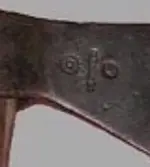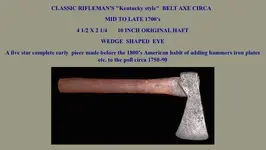lenmac65
Silver Member
- Joined
- Jul 28, 2009
- Messages
- 2,818
- Reaction score
- 9,114
- Golden Thread
- 3
- Location
- Massachusetts
- 🥇 Banner finds
- 3
- Detector(s) used
- Garrett AT Pro, Equinox 800 (as of 10/2019)
- Primary Interest:
- Metal Detecting
I dug this axe head about a week ago by a pre-1850 cellar hole and posted it on the “what is it” forum. I got some good feedback that confirms my thinking that this is possibly a 1700s belt axe or hatchet/tomahawk. It is about six inches long, has no back edge poll to speak of, and appears to have a seam, perhaps formed when the iron was folded over in the forging process. I also see a small vertical indentation, which I think might be the remains of a blacksmith maker’s mark, similar to the one in the non-dug photo of a 1700s trade axe. The axe shape looks very similar to this Kentucky Style axe I found posted online, which also claims to be 1700s. I have not dug many other items to help date it, though I did find (and post) a 1700s coin spill about 100 feet from this hole back in January (two Fugios, 1754 2-reale, and a 1797 LC). I am pretty excited about this axe, and will hang it in my shed with some other axes, horseshoes, and locks. If anyone on this forum has any thoughts about the age or axe type, I’d love to hear them. Thanks and happy hunting.








Upvote
34





